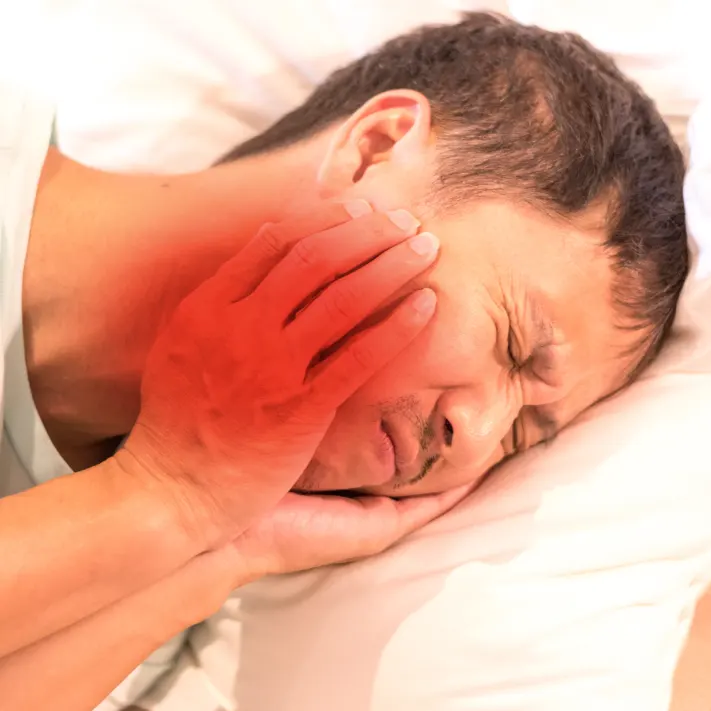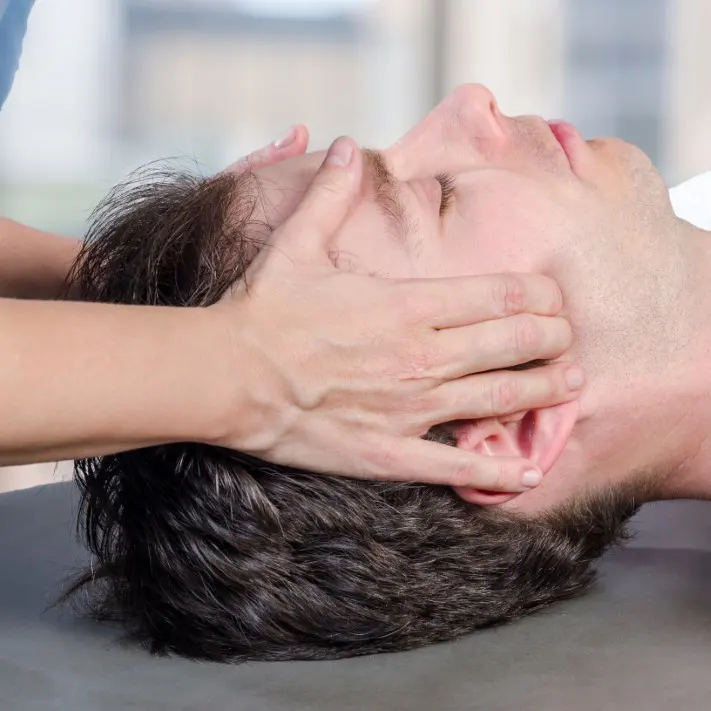What is TMJ pain?
TMJ pain is also referred to as temporomandibular joint disorder or TMD. We have two TMJ’s, one on each side of the jaw, in front of each ear. TMD may cause you to feel stiff or achy, become tender to the touch, and/or experience sharp TMJ pain. In addition to pain/discomfort, TMD may also cause dysfunction. TMD can limit your mouth from being able to fully open, cause your jaw joint may make a “popping” or “clicking” sound, or lock your jaw so it cannot be closed. Physical therapy is used to treat TMJ pain and can be a successful method of TMJ treatment to relieve these symptoms.
Understanding TMJ Anatomy
The temporomandibular joint (TMJ) is a hinge joint that connects the mandible (jawbone) to the skull. Each person has two TMJ joints, one on each side of their jaw. These joints allow for a wide variety of movements, including eating, talking, laughing, and yawning. Each temporomandibular joint (TMJ) is located just behind the trigeminal nerve, the hub in a network of cranial nerves, which allows the face to feel sensation, recognize pain, and chew. TMJ issues commonly affect the trigeminal nerve, resulting in pain that can be felt throughout the face, head, and neck.
Causes of TMJ Pain
There are many possible factors that may lead to TMJ pain. It may be related to genetics, injuries, or acquired/subconscious habits. Symptoms may come on suddenly for some, while others may suffer with TMJ pain for months or even years. It is also possible to have “flare-ups” where TMD symptoms infrequently come and go. Common causes of TMJ pain include:

TMJ Pain Symptoms
The most common symptom of temporomandibular joint disorder is pain, but TMD may also cause issues with the jaw’s ability to move and function normally. Pain is often felt near the TMJ joint(s): in the teeth, mouth, or jaw; or throughout the head, throat, neck, or shoulders. Some people with TMJ disorder even experience blurred vision or ringing in their ears. Common symptoms of TMJ pain include:

TMJ Pain Treatment
Physical therapy is an effective option for for those needing TMJ relief. During your first appointment at SportsCare, you will have a professional evaluation with a physical therapist. Together, you will discuss your symptoms and whether or not you are an appropriate candidate for TMJ physical therapy. If you are, your physical therapist will create a custom TMJ treatment program. This may include:
- Modalities (ultrasound and ice/heat)
- Joint mobilization
- Manual Therapy
- Soft tissue massage
- Posture mechanics
- Home exercises
- Education for symptom prevention

Frequently Asked Questions
-
When should I attend physical therapy for TMJ treatment?
If you are currently experiencing TMJ pain and/or TMJ dysfunction, you should consider attending physical therapy at SportsCare for TMJ treatment. At your initial evaluation, your physical therapist will listen to your TMJ concerns, link habits that may be worsening your symptoms, and assess the movement patterns of your jaw. This will allow your PT to correctly identify the cause of your TMJ issues and create an effective treatment plan for lasting TMJ relief.
-
How long will I need to attend TMJ physical therapy?
The length of time needed in TMJ physical therapy varies from patient to patient, depending on the anatomy/misalignment of your jaw, habits that may exacerbate your TMJ symptoms, computer/work ergonomics, etc. Many patients report that even a few sessions of physical therapy can provide significant relief from TMJ pain. Some patients may need as few as one PT visit while others may need physical therapy for a couple of months to overcome their more severe TMJ pain symptoms.
-
When will physical therapy start to provide TMJ relief?
Some patients report TMJ pain relief in as little as one physical therapy appointment, while others with more severe pain/dysfunction may need TMJ treatment over the course of a couple months. In addition to using modalities, manual therapy, and soft tissue massage at your in-office PT appointments, your physical therapist will demonstrate ways to improve your posture and ergonomics, as well as develop a customized home exercise program to help relieve your painful TMJ symptoms.
-
Does SportsCare take my insurance?
Here is a list of the insurance plans accepted by SportsCare Physical Therapy and Armworks Hand Therapy. If you are unsure of your coverage or if your plan is accepted, please contact one of our offices. We are happy to assist you in learning about your benefits.
-
Where is SportsCare Physical Therapy located?
SportsCare Physical Therapy has offices in Gresham, Sandy, NE Portland, Clackamas, Beaverton, and Salem. For location specific contact information click here.
